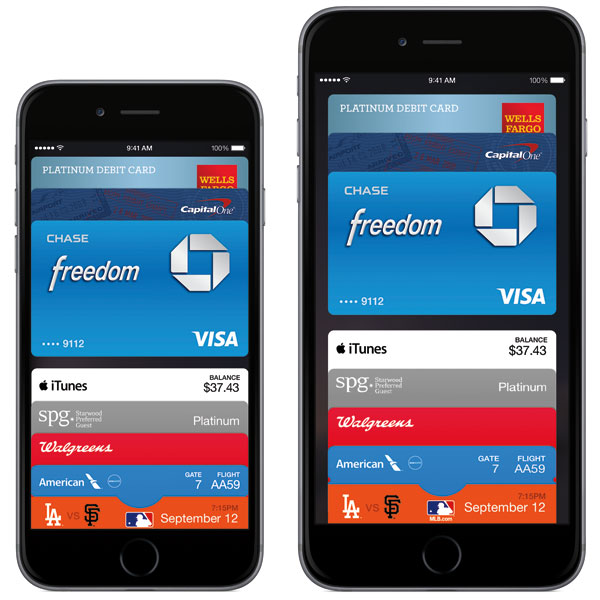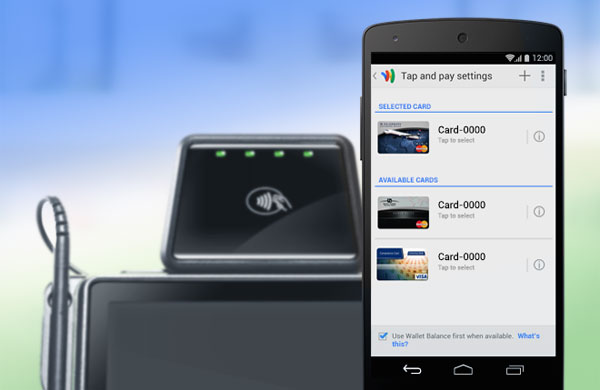Google Wallet (pictured above) suddenly has experienced a surge in use, according to an Ars Technica report that cites an unnamed source.
Weekly transactions are up 50 percent, and the number of new users has nearly doubled from the prior month, the source said.
Obviously, the primary explanation for this sudden leap is Apple’s entry into the mobile payments world. It introduced Apple Pay in September and rolled it out officially October 20.
Google Wallet, by the way, has been available for real-world use since 2011 — even gaining the ability to work with all major credit cards in August of 2012.
So, was the U.S. market just not ready for mobile payments, or did Apple make it ready?
Not So Fast, Mr. E-Wallet
Apple Pay and Google Wallet, as well as CurrentC, etc., all have a long way to go before they seriously displace standard credit and debit card usage. That said, Apple just doesn’t sell its own products and services. The company from Cupertino is one heckuva catalyst for others, too.
Consider this: Even when Apple technically follows the product rollout of some other company, Apple often manages to become the product segment leader.
That’s amazing. How does that work, anyway? Many other companies follow, refining and fixing the products and ideas of companies that made it to market first — but few evolve into any real leadership position.
You could say it’s just because Apple is big — but Apple wasn’t always big. You could attribute Apple’s success to Apple’s rabid fanboys. But Google is big, and Google has rabid fanboys. Yet NFC payments via a smartphone — even with so many Android devices out in the world — barely registered a blip on radar of consumer consciousness.
Apple, on the other hand, activated more than a million Apple Pay accounts in just 72 hours. Then it hit the retail channels with enough force to promptly cause CVS and Rite Aid to stop taking payments from both Apple Pay and Google Wallet, which caused a ruckus over the fledgling MCX CurrentC payment effort, too.
No doubt about it, Apple’s entry into a market sparks attention — and even real buying activity — for competing products, ironically giving Apple alternatives a kick in the pants and a chance to thrive.
What gives? I see a few key reasons.
Silence Is Golden
Apple remains essentially silent on anything it doesn’t yet produce. This means that Apple gives no mindshare to the solution or product produced by someone else. If asked directly about it, Apple executives either avoid the question or dismiss the consumer interest, the product, or the service structure around the product.
While NFC has been out for years, Apple has said as little about the notion of mobile wallets as possible. So when Apple does introduce a new product, the public beyond the tech news followers hears about it as if it were a brand new, fresh idea.

Instead of hearing lots of trickles here and there along the way, learning enough to not really care about the product so much, Apple’s sudden voice causes the general media and public to sit up and pay attention.
So far, so good. Other companies are trying to be silent now, too, with various levels of success. But silence is just one element.
Product Experience
While Apple is being silent, it focuses on the product experience, often for years, trying to make the product itself the best possible incarnation of what it is supposed to be. Once the product is honed down into its essence — not jacked up with all sorts of extra features or abilities — Apple has created something the masses can understand.
It makes sense to a large population of moderately tech-savvy consumers, and it’s understandable to plenty of tech-challenged people, too. Apple stopped shipping instruction manuals years ago, because it strove to make products intuitive enough to use without them.
When Apple does roll something out, regular people can use it. It seems simple, but it’s core to how Apple is able to drive immediate consumer action.
Smart Advertising
Even though Apple does not spend much on advertising to the tech press — the same tech press that gives it so much love (and sometimes hate) — Apple spends on TV advertising. Apple not only buys lots of high-profile spots, but also spends a lot of serious time and effort crafting its messages to focus on two things: 1) the product, the product, the product; and 2) a few core human benefits that the product brings, usually promising a better, easier, more enriching life.
The advertising helps drive awareness — and Apple keeps at it. I see other tech companies come out with a series of great ads right around a product’s launch, but then their budget runs out and they stop advertising. By the time Apple starts advertising a product, the company believes to its very core that it has developed the best possible product, and it will keep advertising it until it finally resonates with buyers.
Other companies have produced some sweet tablets with some cool features and compelling prices — but do these companies have the corporate will to shape perception for months and months? Because Apple seems to invest its soul into the products it produces, I think it is willing to promote them harder and longer, which ultimately pays off.
Will Microsoft pull the plug on Surface Pro advertising before it gets the software experience sorted out in a way that appeals to mass consumers? Probably.
The Wild Card of Me-Too Jealousy
The last factor that plays well for Apple is jealousy. Once everyone knows about a certain feature, the non-Apple users start looking to see if they can do the same things with their devices that Apple owners can do. Is this jealousy? Or is it just a sudden awareness of a possibility they had all along? Both, definitely. Here’s an example. After getting my iPhone 6, I was playing with the slo-mo feature and showed a cool clip to my buddy, who’s a diehard Android guy with a Samsung Galaxy S5.
He wanted to shoot slo-mo video on his S5, suddenly, and figured he surely must be able to do it, too. He went looking for it but couldn’t find it right away. I told him, “You’ve got to have it — that’s Samsung’s best device — if not built-in, then probably through an app.” Sure enough, he found how to shoot slo-mo video and figured out how to use it, after owning his S5 for months.
Back to Google Wallet and Apple Pay — and even Ars Technica. Writer Megan Geuss recently spent a week with Apple Pay using an iPhone 6 review unit. While she’s not going to rush out and buy an iPhone for herself, she did acknowledge the Apple effect: “The experience even renewed my interest in Google Wallet.”
To its competitors, Apple has got to be the most maddening — and simultaneously important — company in the tech world today.






















































